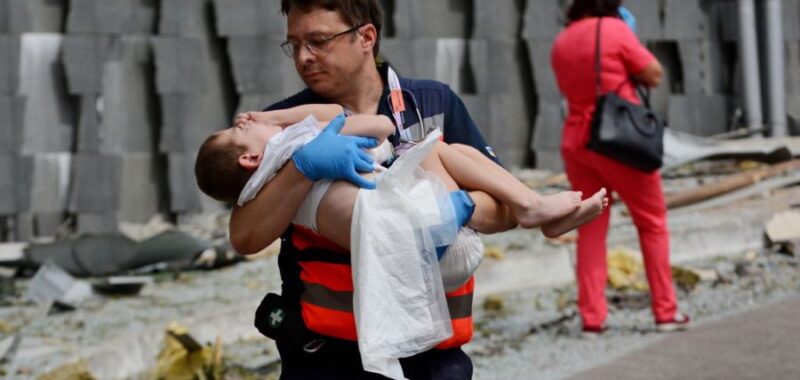
As I walked to my meeting on Monday morning in Kyiv, the explosions tearing up the sky and the rising smoke seemed almost routine. I joined the people gathered near the subway entrance, looking on as missiles pierced the horizon seemingly close to us. Together, we watched the explosions and heard their thundering sounds with little reaction — after years of war and months of aerial bombardment and power blackouts, nothing fazes us.
Then came the searing images of the destroyed Okhmatdyt Children’s Hospital. Ukraine’s largest children’s hospital and one of the largest in all of Europe, Okhmatdyt was once a proud symbol for the country and a state-of-the-art medical center for specialized care, including cancer treatments. But the place where thousands of tiny patients received a promise of a healthy life was now in ruins. Children who had been in the middle of complex surgeries and dialysis were riddled with shrapnel.
The head of the UN human rights monitoring mission reported that the strike on Okhmatdyt Children’s Hospital was likely caused by a direct hit from a Russian missile. The July 8 assault on the hospital was part of a series of attacks that killed at least 47 people across Ukraine, including children.
Some international observers were shocked by the brutality; who would attack a children’s hospital? But if you think the attacks on Okhmatdyt and the subsequent attacks on two other medical centers in Kyiv were accidents or isolated incidents, think again. We here in Ukraine know this barbaric pattern of violence all too well.
Physicians for Human Rights (PHR) and our partners have been documenting and monitoring attacks on health care since the beginning of the full-scale invasion of Ukraine. PHR is constantly analyzing these patterns of violence and our analysis strongly suggests that Russian attacks on Ukraine’s health care system are not isolated incidents but systematic acts of violence. They likely constitute war crimes and crimes against humanity.
Since the invasion began, PHR has recorded 79 attacks affecting children’s health care, including 54 that destroyed or damaged children’s hospitals, and at least 60 attacks affecting maternal health care, including 38 that destroyed or damaged maternal health care facilities.
By attacking health care sites — particularly those that serve pregnant patients, parents, babies and children — Russia knows exactly what it is doing. It is preventing children from accessing life-saving health care, now and for the near future. It prevents pregnant patients from receiving the essential pre-, ante, and postnatal care that they need. In short, it is trying to destroy Ukraine’s future.
These attacks on health cannot be looked at in isolation from other acts of violence. International prosecutors must examine these attacks in conjunction with the deportation of Ukrainian children to Russia, the coercive practice of “passportization,” wherein Ukrainians are forced to assume Russian citizenship, and Russia’s widespread and systematic use of torture against Ukrainian people. These are reasonable inquiries for international lawyers when considering the Russian invasion as potentially indicative of genocidal violence. After all, in the context of the Genocide Convention, these attacks could indicate the intention to prevent the birth of children, from the bombing of the maternity hospital in Mariupol in the first days of the full-scale invasion in 2022 up to today.
This strategy of destruction is painfully familiar to my PHR colleagues. In Syria, PHR has documented widespread and systematic attacks on health care. The scale, frequency and intensity of these attacks peaked in the two years following Russian intervention. In 2023, our team interviewed over 260 respondents, mostly women, who reported that continued violence in Syria significantly hampered access to maternal care. This lack of access led to denials and delays in care, as well as deaths.
Russia’s repeated patterns of violence against health care in Chechnya, Syria and now Ukraine violate international law and norms — with devastating impacts on maternal and child health. This violence is compounded by relentless attacks on Ukraine’s energy infrastructure, which has cascading effects on the health care system. Without electricity, hospitals rely on expensive, unsustainable generators, limiting their functionality.
With no international court currently pursuing accountability for attacks on health care, the foundational norm of health care protection erodes further. Perpetrators feel emboldened to weaponize health care for military advantage. Indeed, the attacks on health care crisis rages far beyond Russia’s wars: Assaults on patients, clinicians and hospitals have been brutal hallmarks of the conflicts in Gaza, Sudan, Myanmar, Democratic Republic of Congo and beyond as well.
The United Nations Security Council condemned attacks on health in a 2016 resolution, but the problem has grown significantly since then. Perversely, Russia again assumed the rotating presidency of the Security Council on July 1, just one week before its gruesome attack.
But while the UN strains under its twisted rules, accountability for these crimes must still be pursued. National and international prosecutors alike must prioritize investigations of attacks on health. The international community should pressure states, without regard to political considerations, to stop these attacks and enhance training of militaries to protect health care. There also needs to be improved documentation of these kinds of attacks and better sharing of information with accountability mechanisms.
Unlike the smoldering rubble at Okhmatdyt Children’s Hospital in Kyiv, attacks on health care cannot be extinguished until there is real accountability for the perpetrators. When will the world act to prevent another missile strike on another children’s hospital? When will we put out the fires?
Uliana Poltavets leads Ukraine research for Physicians for Human Rights.

